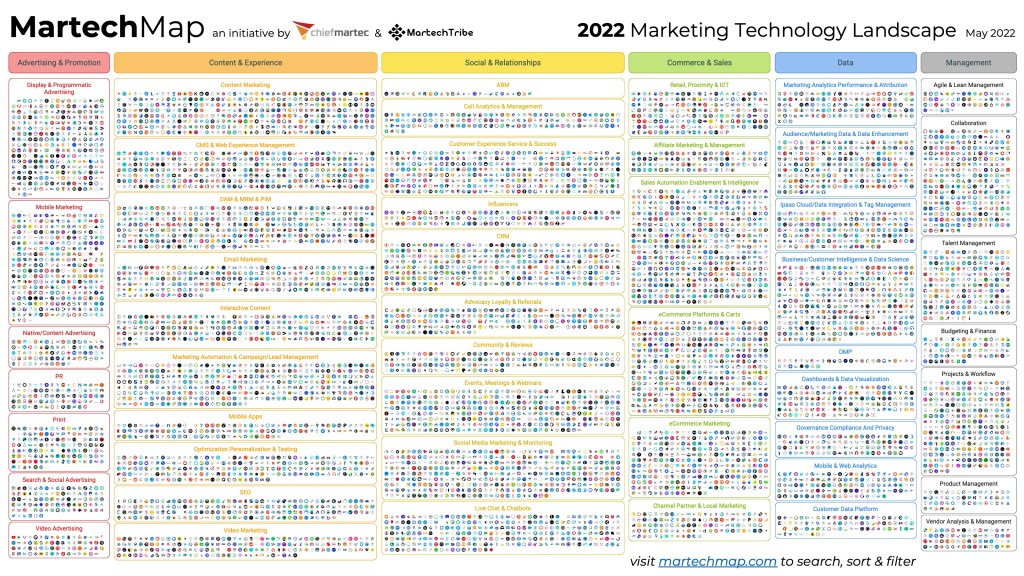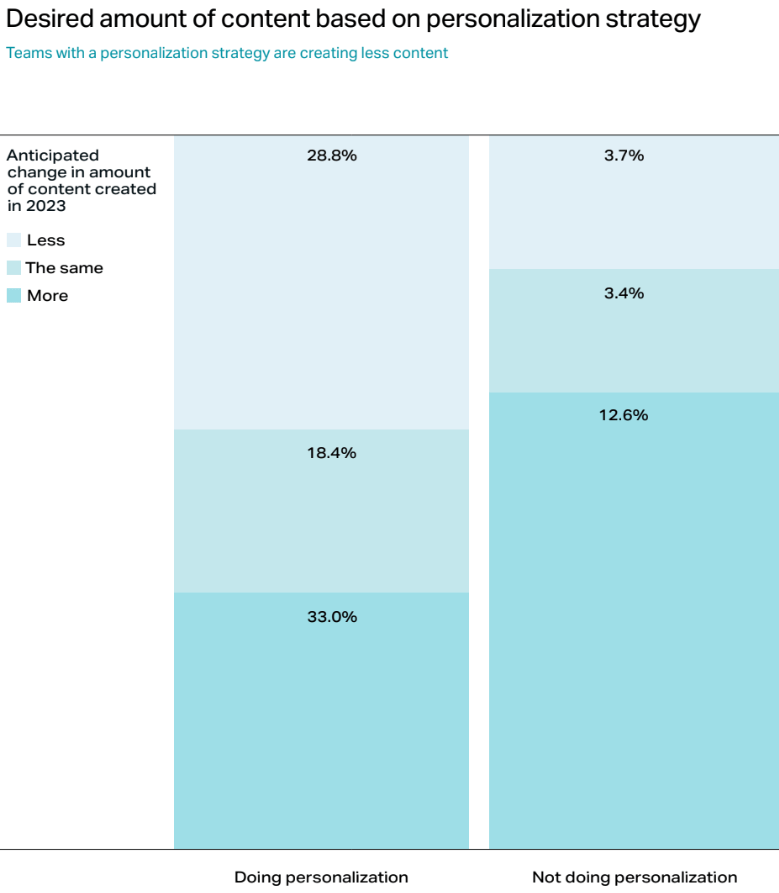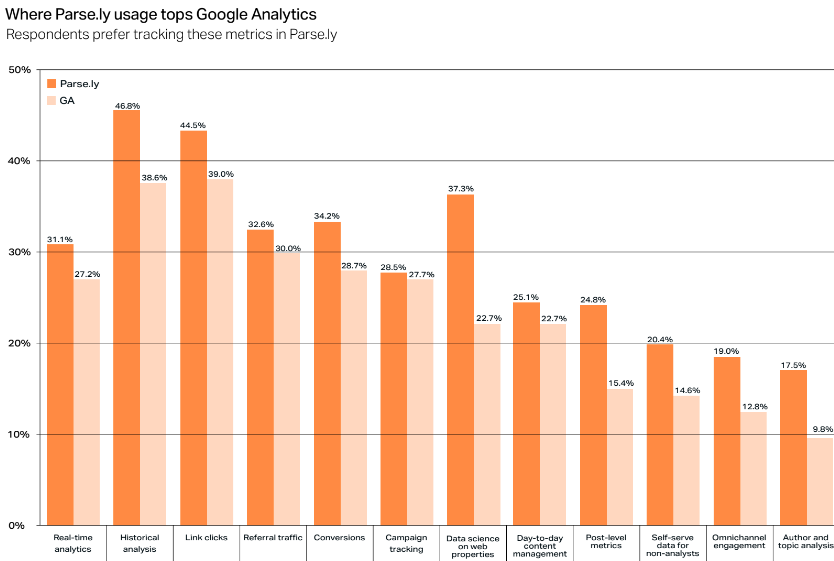Top 5 Content Marketing Trends for 2023

News headlines teem with stories of massive tech company layoffs. But while concerns about the economy and the looming recession have driven many to make cuts, trends identified by WordPress VIP’s Content Matters 2023 Report show content teams and budgets are still growing.
In our webinar Data Is the Spark: Inside Our Content Matters 2023 Report, WordPress VIP content marketer Kayla Mehojah was joined in conversation by Uberflip Chief Evangelist Randy Frisch and Aprimo Chief Marketing Officer Ed Breault. They unpacked the major takeaways from the report and offered their takes on this year’s top five biggest trends.
- Budgets and teams are growing, despite economic uncertainty
- Content teams are focusing on quality over quantity
- Personalization is the new SEO
- Data should be the building block of your content strategy
- Do more with less by focusing on what matters
#1: Budgets and teams are growing, despite economic uncertainty
The past few years have seen a significant shift in how content is produced, largely due to the pandemic and economic uncertainty, which forced marketers to rely on digital content to connect with their audiences in new and captivating ways. In fact, 82% report the need for revenue-driving content has increased.
That trend was no surprise to Randy, who not only expects this growth to continue but also believes it will force content strategies to continue evolving.
Persevering through content
Content is a core competency for brands, reliably serving them well during economic downturns. The key to navigating challenging times, according to Bain & Company, is to put the right content in front of the right people at the right time.
The goal isn’t to become a content vending machine but rather to produce content of high quality that attracts not only internal leadership buy-in but also increased customer engagement.
How can content be used to push for more leadership buy-in and resources?
The answer is using data to prove return on effort (ROE). ROE is a twist on the standard ROI formula, providing a more comprehensive view of the amount of work required to produce target outcomes for an organization.
Our research found nine in 10 teams with leadership buy-in have content goals tied to revenue. Data that supports revenue outcomes for the business, like a positive ROE, can persuade even the most stubborn leader how important content is to achieving objectives and overall goals.
Content ops is the new marketing ops
Ed was relieved to see the data related to content teams and budgets, and he championed the support of leadership for teams to continue to invest in content.
He believes content operations has become the new marketing operations, taking over a hefty segment of the 9,000+ marketing solutions landscape in 2022, as much of marketing operations now involves content in some capacity. The rhythm of the marketing machine—involving people, process, and technology—has centered on building customer relationships and fostering those relationships organically through content.

#2: Content teams are focusing on quality over quantity
Did you know roughly 70% of content goes unused?
It’s no surprise that content marketers are shifting their focus to quality over quantity, with just 61% of respondents planning to produce more content this year (down from 66% last year) and 18% producing less (up from 9%).
Limited resources, burnout, and improvements in strategy are behind this trend. Hiring talent continues to be a major challenge (and often burnout, unfortunately) as marketers try to meet the demand and accelerate efforts to improve overall strategy.
Randy noted that when sales representatives send outdated content that is no longer on brand, it’s time to reconsider and improve the content experience for your audience.
The vast wilderness of unworthy content
Ed refers to the vast wilderness of unworthy content as “content pollution.” What qualifies as such? Anything that is not tied to revenue goals, doesn’t resonate with audiences, and/or takes up space in your portfolio.
To help refine your content, Randy and Ed suggest a four-step self-assessment approach.
Be bold and produce less
Reduce content pollution by emboldening your team to produce less content by focusing solely on what your audience is looking for most. Listen to what the sales team is asking for, what your prospects are asking for, and what problems your customers have.
Clean house like Marie Kondo
We can all learn a lesson from professional organizer Marie Kondo. She famously asks a single question to determine whether an item is worth keeping or giving away: Does it spark joy?
If your content doesn’t spark joy in the hearts of readers, throw it out. Highlight the content on your channels that is engaging and helpful, and most of all, converting visitors to leads.
Shift your mindset from calendar to campaign
Most content marketers are stuck with a content calendar mindset, where content, whether needed or even impactful, is rotely pushed out at fixed intervals. Instead, shift to a campaign mindset where you ask yourselves:
- What are the different campaigns I need to meet my customer at the right time?
- What gaps do I need to fill?
- How much content are we actually keeping that’s no longer relevant?
- How much high-performing content do we update to be even more relevant now?
Learn and navigate the 4 V’s
The 4 V’s are volume, variety, veracity, and velocity. Use them to assess your current portfolio.
- Volume: Is there a high volume of content being produced that contributes to a lot of waste and content pollution?
- Variety: Are there variations in your content in types, topics, and channels?
- Veracity: Is your content accurate and factual?
- Velocity: How can you slow down and be more conscientious and intentional with what you’re doing?
Use these steps to reflect on your content strategy and help produce better content at a lower volume.
#3: Personalization is the new SEO
The claim that personalization is the new SEO made Randy and Ed smile. Both liken SEO and personalization to a healthy marriage: they take a long-term commitment but when done right and consistently, they are very rewarding.
Unfortunately, many marketing teams view personalization as confusing and cumbersome.
The challenge of personalization
Eighty percent of marketers will abandon their personalization efforts by 2025 due to a lack of ROI. The death of the cookie and ongoing customer data management problems have led marketers to wonder:
- When it comes to personalization, should we focus on the who or the where?
- Will our personalization strategy scale?
- What kind of content works best?
The biggest challenge with personalization is finding a balance between creating meaningful experiences for audiences without pushing them away. Ed cites Disney, who focus not on niche content (movies designed to appeal to a specific age group in a specific city), but rather on creating more universal, personalized experiences the Disney audience as a whole can value.
A good personalization strategy is worth the “work smarter, not harder” effort, born by the fact that teams doing personalization right often want and need to create less content.

#4: Data should be the building block of your content strategy
Fewer than half of 2023 Content Matters Report respondents use content analytics to make content strategy decisions, an eye-opening statistic even for our experts. Perhaps more concerning, 24% of respondents who do measure content still don’t have a clear picture of their performance, due in part to the complexity of their tools.

Marketers need to assess what tools work for their teams and how those tools are best used. For example, Randy and his team have a very focused customer profile they track. He says to go beyond surface-level metrics, such as bounce rate and aggregate views, and dig deeper into the account level to understand how certain buyers are engaging with particular content.
Instead, take user engagement-level metrics and establish a strong customer journey you can use to inform content and distribution decisions.
If you can’t measure it, why are you doing it?
Content analytics is a combination of art and science, helping you understand what is actually moving someone through the buyer journey. Tying KPIs like revenue, growth, and conversions back to business objectives garners leadership buy-in and support, which should spur team and budget growth.
What about the 54% who don’t currently use content analytics to make strategic decisions? Perhaps they don’t yet understand how to create data narratives to connect metrics with business objectives, or may not have an analytics tool they actually know how to use. If that’s the case, this needs to be on their shortlist of strategy improvements immediately, Ed and Randy suggest.
What data are you trying to understand?
Everyone within the organization should be looking at content analytics and understanding the implications of data, for them and their team. Sales representatives, for example, should understand which content assets users are clicking on and when. If an email went out at 2:00 p.m., knowing a prospect opened it two hours later and clicked through to a certain blog is invaluable, must-have intelligence.
Being able to monitor this level of engagement in real time helps stakeholders make decisions about how best to approach the buyer journey.
#5: Do more with less by focusing on what matters
Producing less content works when you focus on what matters. A “maniacal focus,” as Ed suggests, means learning what’s truly meaningful and doing that well.
Content challenges
A lack of resources is an ongoing issue for marketers. To overcome this, focus on what resources you do have and do the most with them.

“For every resource you are given, expectations will rise,” says Randy. Determine what you’re trying to accomplish with your content and rally your people there. Talk to stakeholders, both inside and outside the organization, to understand where content is needed.
Use content analytics at every step, whether it’s proving the value of your content to leadership, or simply deciding what to publish next. Data is the spark that will ignite a strong content strategy and further organizational growth, even during tough times.
Want to learn more about how to overcome common challenges in content marketing?